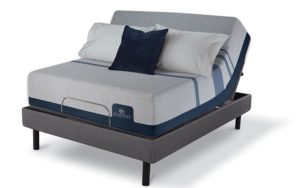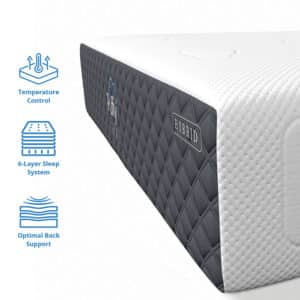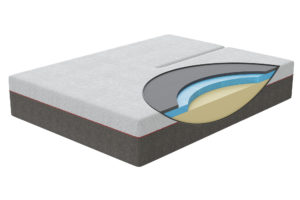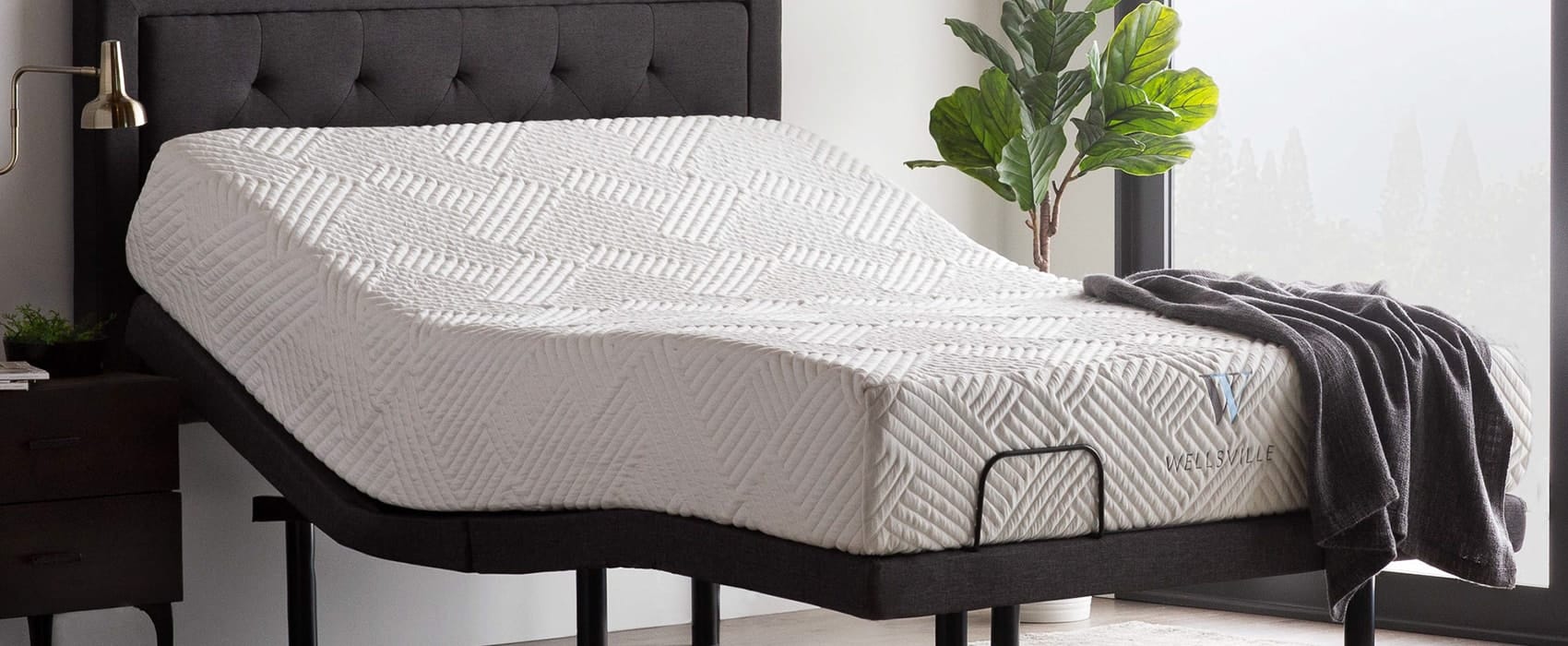Explaining Memory Foam
The energy-absorbent viscoelastic polyurethane foam, known as Memory foam, actively molds to your body in response to heat and pressure. Memory foam mattresses evenly distribute your body weight and then return to their original shape once pressure from your body is removed. This provides health benefits like:
- uniform body support
- alignment with the curvature of your spine
- alleviation of joint and back pain
- pressure point relief
- motion isolation.
Memory foam is denser and more supportive than the average polyurethane foam used in mattresses. It cradles and remembers your body and slowly returns to its original form, hence its name. It is also hypoallergenic and prevents allergy-causing dust mites and other allergens from collecting within your bed.
Memory foam was an unexpected discovery for the mattress industry. NASA developed memory foam in 1966 to increase aircraft safety upon impact. It was then used in hospital beds and for medical purposes until 1991 when memory foam was adapted for public use. It is now popular in various industries where comfort and support are necessary. Memory foam mattresses are one of the most popular mattresses sold today.
Components of Memory Foam

Polyurethane
Polyurethane, the main ingredient in memory foam, is a lightweight material that is easily compressed. Its structure adds softness and support to a memory foam mattress.
Diisocyanate
Diisocyanate is a chemical compound added to the polyurethane substance to enhance the support, comfort and durability of the mattress material.
Water
Water causes the foam substance to rise with an open cell structure.
The right combination of this trio controls two critical qualities of memory foam: viscosity (how long it takes to change shape under pressure) and elasticity (how much the material can stretch or contort without losing its original shape or size).
Memory Foam Layers
The highest-quality mattresses have five or more layers. The thickness, density and construction of each layer affect the overall quality of the bed. A high-quality memory foam mattress will be constructed with multiple layers of comfort material, a layer of transitional material and a solid support core.
Comfort Layer

The ratio between the support layer and comfort layer will differ based on the comfort layer you wish to obtain and the type of foam you choose. Firmer mattresses will have more support foam and less comfort foam, while a more plush bed will have an equal representation of both support foam and comfort foam.
Transition Layer
The transition layer is generally just a few inches of supportive polyurethane foam to provide a buffer between the comfort core and support core. It may not be necessary in an all-foam mattress.
Support Core
The bottom layer of a mattress is the support layer, which is the core of the mattress. It can contain one to three different materials. The support layer’s main purpose is to reinforce the rest of the mattress by providing proper spinal alignment and body support while preventing the body from sinking too far down into the mattress. This layer also plays a major role in temperature neutrality, noise control and the overall longevity of the mattress.
In a memory foam mattress, the support layer normally consists of a 6” to 8” layer of high-density, durable polyurethane support foam, but some of the higher-end hybrid memory foam mattresses use latex as their support layer instead.
In many hybrid mattresses, the support layer will consist of a 1” layer of high-density, durable polyurethane support foam followed by a coil system.
Types of Memory Foam Mattresses
A brief overview of the different types of memory foam mattresses will help you decide which mattress is best suited for you.
Traditional Memory Foam
Traditional memory foam actively responds to heat and is temperature sensitive. In its early days, its heat-retaining property was a complaint from warmer sleepers but loved by cold and medium sleepers. In the 2000s, open-cell memory foam, gel memory foam and other mineral-infused memory foam like copper, graphite or carbon were introduced. Each option combats heat retention and helps regulate body temperature. This is an important feature to search for when you decide to buy a memory foam mattress.
Take our Express Comfort Quiz for instant recommendations.Not sure which mattress is right for you?
Open-Cell Memory Foam
Open-cell memory foam is similar to traditional memory foam but has a different internal structure. The mattresses have internal pockets known as “open cells,” hence the name. These cells allow for ventilation and airflow throughout the mattress, helping disperse heat and retaining a more cooling effect than traditional memory foam.
Gel Memory Foam
Another way manufacturers have combated the heat-retaining properties of memory foam is by incorporating gel in its construction. Gel is added to the mattress by pumping gel-based microbeads into the memory foam. The gel creates pockets similar to those that exist in open-cell mattresses. Instead of simply letting air flow through the mattress, these gels create a phase-changing material that actively absorbs and releases heat from your body.
Mineral-Infused Memory Foam

Graphite is a form of crystalline carbon that is very soft as well as resistant to heat. The secret to graphite’s cooling success is its small spherical pores, which allow it to absorb heat better than other elements. To make graphite memory foam mattresses, graphite is either mixed into the foam itself or applied as a thin, separate layer on the top of the mattress. The weight of the sleeper sinking into the foam forces the graphite particles closer together, allowing them to conduct heat through the foam and dissipate it quickly.
Mattress Express favorites include the IFS Chill Series, Puffy, the Wellsville Air Foam Gel Series and the Posh and Lavish Hybrid Collection.
Other Memory Foam Considerations
Memory Foam Density
Like any material, the quality of memory foam can differ.
An important feature to pay attention to is the density of the memory foam used to make your mattress.
The density of memory foam used for mattresses can vary from 1-pound density to 5-pound density. A mattress made with 3- to 4-pound density or higher should last you over a decade. 1-pound density mattresses could develop body impressions and need to be replaced as early as a year or two after purchasing. The lower-density foam mattresses may sell for a low price but that quality varies as well when comparing the long-term cost. You may want to spend a little more now to save money in the future.
Heat
Temperature-controlled mattresses have become a desired commodity in the mattress world.
Natural latex foam is one of the most breathable mattress materials available, while gel memory foam, open-cell memory foam, and mineral-infused memory foam balance the heat-retaining properties of standard memory foam to give you a comfortable night of sleep.
Response Time
The response time of your memory foam mattress is measured by how quickly it bounces back to its original state. It is rated by a number of factors, such as the composition of the foam, changeable viscosity, the rate of elasticity and resilience. The faster your mattress lets go of your body weight, the more pressure relief you will receive. Lower-quality memory foam may have a slower response time, causing issues for older people or those with mobility issues.
Mattress Thickness
Although a standard mattress may be about 8” thick, luxury mattresses tend to range from 10” to 18” due to the oversized support and comfort layers that make each mattress unique in design.
A 10” memory foam mattress tends to have a firmer feel while a 14” or larger memory foam tends to have a plush feel.
Sleeping Positions
Side Sleepers
Sleeping on your side is the most common sleep position and is good for your long-term health. A plush memory foam mattress is perfect for side sleepers as they provide an extra layer of cushioning to protect shoulders, hips and ankles from discomfort.
Back Sleepers
Sleeping on your back is great for your health as your body weight is spread evenly across your mattress. The best memory foam mattress for a back sleeper should be a balance of support and comfort.
Stomach Sleepers
If you sleep on your stomach, it is best to buy memory foam that has a firmer feel to minimize the overarching of your spine.
Buying Memory Foam
Now you know how to pick a mattress that is ideal for you, stop into any of our Mattress Express locations and one of our sleep specialists will point you in the right direction.
Be sure to ask about each mattress’s individual mattress warranties, what the delivery options are for your favorite choices and the timeframe in which you can expect to have your mattress in your home. This, too,k may help you decide on the best type of mattress for you.

